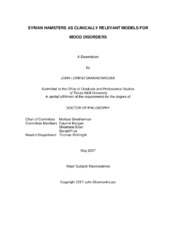| dc.description.abstract | Anxiety and depressive disorders are the two most common types of mood disorders in the United States. These disorders are more likely to affect women than men. Animal models do not cover key aspects of mood disorders well, including sex biases, links between metabolism, HPA activity, social status and anxiety and depression as well as paradoxical effects of antidepressants on some adolescents. It is reported here that two novel tests, the anxiety feeding/exploration conflict (AFEC) test and the reward/investigational preference (RIP) test, are suitable for measuring anxiety-like and depression-like behavior in Syrian hamsters (Mesocricetus auratus). Furthermore, biometrics including body weight, food intake, indirect calorimetry, plasma assays and tissue weights measured metabolism. Gene expression and electrophysiology were used to measure brain function. Pharmacological interventions manipulated behavior and metabolism. Animals were manipulated through social housing (SH, 2 or more animals per cage) and social separation (SS, one animal per cage) and pharmacology to model mood disorders in humans.
Relative to SH, SS hamsters show a combination of increased metabolic rate, hypophagia, decreased adiposity, decreased lean mass, low HPA activity and increased anxiety-like and depression-like behaviors with a profound female sex bias. Relative to adult female Syrian hamsters, adolescent female Syrian hamsters show aberrant responses to the antidepressant fluoxetine including increased anxiety-like behavior, increased depression-like behavior and anxiety-like and depression-like behavior that do not improve over the course of the experiment. In addition, there are divergent responses of gamma-amino butyric acid (GABA) miniature inhibitory chloride currents and divergent GABA-related gene expression. Thus, the Syrian hamster model shows advantages over related models in rats and mice for some aspects of modeling anxiety and depression. | en |


